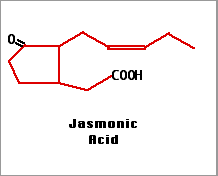Jasmonates are a small group of related molecules derived from linolenic acid. The first to be identified was isolated from the oil of Jasminum officinale, the Poet's or Common Jasmine. This vine — the national flower of Pakistan — is grown as an ornamental along the southern tier of the United States and the coast of California.
The most abundant member of the group is jasmonic acid (right).
Jasmonates are produced in several parts of the plant and travel in the phloem to other parts where they turn on (or repress as the case may be) gene expression. They bind to the promoters of their gene targets.
Jasmonates, like most of the other plant hormones, are implicated in a bewildering variety of functions. In one species or another, theySome of these functions have been demonstrated by the application of jasmonates to the plant and may not present an accurate picture of the role played by the jasmonates produced within the plant itself.
One function that is clearly mediated by endogenous jasmonate synthesis and translocation is the plant's response to damage, for example, by herbivorous insects feeding on it or by pathogens (e.g. fungi) invading it. In this case the response is to turn on the expression of genes that encode a variety of defenses against the damaging agent.
| Other plant hormones | ||||||
|---|---|---|---|---|---|---|
| Abscisic acid (ABA) | Auxin | Brassinosteroids | Cytokinins | Ethylene | Gibberellins | Strigolactones |
| As you read about these various hormones, you will note that: (1) each hormone affects several, or even many, different processes and (2) each process is, in turn, influenced by several different hormones. How these overlapping signals are integrated to produce a particular response remains a topic of active research. | ||||||
| Welcome&Next Search |